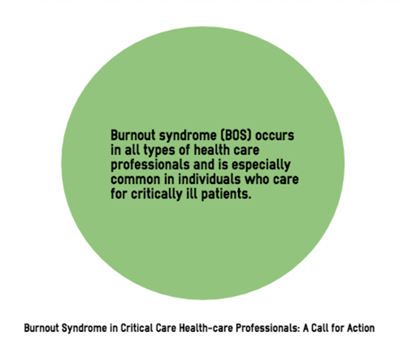GLENVIEW, Ill., July 12, 2016 (GLOBE NEWSWIRE) -- A new report on burnout syndrome in critical care health care professionals gives key stakeholders guidance on mitigating the development of burnout syndrome and calls for initiating research to examine ways to prevent as well as treat burnout syndrome.
The report was published by the Critical Care Societies Collaborative (CCSC), a group consisting of four professional and scientific societies, whose members care for America's critically ill and injured, and aims to raise awareness about burnout syndrome in critical care medicine.
Burnout Syndrome Defined
Burnout syndrome is a state of emotional, mental and physical exhaustion caused by excessive and prolonged stress. This exhaustion is typically work-related and is triggered by discrepancies between the expectations and the actual requirements of the job. Burnout syndrome has become a common worldwide phenomenon, especially among members of high-stress professions, such as firefighters, police officers, teachers and all types of health-care professionals.
Critical care health care professionals have one of the highest rates of burnout syndrome, with nearly half of the workforce exhibiting symptoms.
Burnout in Critical Care – A Critical Situation
The co-published document reports:
- Up to 45 percent of critical care physicians reported symptoms of severe burnout syndrome, while those specializing in pediatric critical care were at 71 percent.
- Approximately 25 to 33 percent of critical care nurses manifest symptoms of severe burnout syndrome, and up to 86 percent have at least one of the three classic symptoms.
- The high burnout syndrome rate in critical care professionals can be attributed to the especially stressful environment in the ICU due to high patient morbidity and mortality, challenging daily work routines, and regular encounters with traumatic and ethical issues.
- Burnout syndrome in critical care health care professionals may result in post-traumatic stress disorder, alcohol abuse and even suicidal thoughts.
- In nurses, burnout is associated with reduced quality of care, lower patient satisfaction, increased number of medical errors, higher rates of health care associated infections, and higher 30-day patient mortality rates.
Next Steps: Exploring Solutions and Research
"Everyone has a part to play in decreasing burnout syndrome. A full collaborative effort is required among researchers, educators, professional societies, patient advocacy groups, funding agencies, policy makers and ourselves as critical care health care professionals" says Dr. Marc Moss, co-author, vice chair of Clinical Research for the Department of Medicine at the University of Colorado School of Medicine, and president-elect of the American Thoracic Society. "We can't take care of patients if we don't take care of each other. An increased commitment to research on burnout syndrome is a necessary first step."
The CCSC call to action advises key stakeholder groups to help mitigate the development of burnout syndrome. Key stakeholders include critical care clinicians, friends and family, ICU unit-based leaders, hospital administrators, funding agencies, professional societies, academic institutions, patient advocacy groups and policy makers. Two potential strategies for dealing with burnout include interventions focused on enhancing the ICU environment and helping individuals cope with their environment.
The CCSC is looking into ways to combat burnout syndrome in the ICU, including analyzing current research on related topics. A study from the journal Academic Medicine noted that the use of mindfulness training in health care professionals has demonstrated beneficial effects including improved attentiveness and responsiveness to patients' concerns and development of adaptive reserve. A 2011 report in Nursing Standard identified problem-focused coping style, self-awareness, and lifestyle and coping strategies as ways to mitigate burnout syndrome. In 2013, ESSAI reported that self-care and stress reduction measures can build resilience to help address and even prevent burnout syndrome.
"With more than 10,000 critical care physicians and 500,000 critical care nurses practicing in the United States, the effects of burnout syndrome in the ICU cannot be ignored," says Dr. Curt Sessler, senior author and immediate past president of the American College of Chest Physicians. "We believe that protecting the mental and physical health of health care professionals who are at risk for burnout syndrome is vitally important for not only the professionals but for all stakeholders, including our patients."
The complete statement can be viewed in the official publication of each CCSC member journal: American Association of Critical-Care Nurses (AACN), the American College of Chest Physicians (CHEST), the American Thoracic Society (ATS), and Society of Critical Care Medicine (SCCM).
Join the conversation at #StopICUBurnout.
Critical Care Societies Collaborative (CCSC) is the combined efforts of the four major U.S. professional and scientific societies with an interest in critical care. The American Association of Critical-Care Nurses (AACN), the American College of Chest Physicians (CHEST), the American Thoracic Society (ATS), and Society of Critical Care Medicine (SCCM) work together to address issues common to members of all four organizations and the patients they serve. CCSC leverages its collective and multi-professional expertise to optimize the care of the critically ill and injured through communication, education, research and advocacy.
A photo accompanying this release is available at: http://www.globenewswire.com/newsroom/prs/?pkgid=40809
